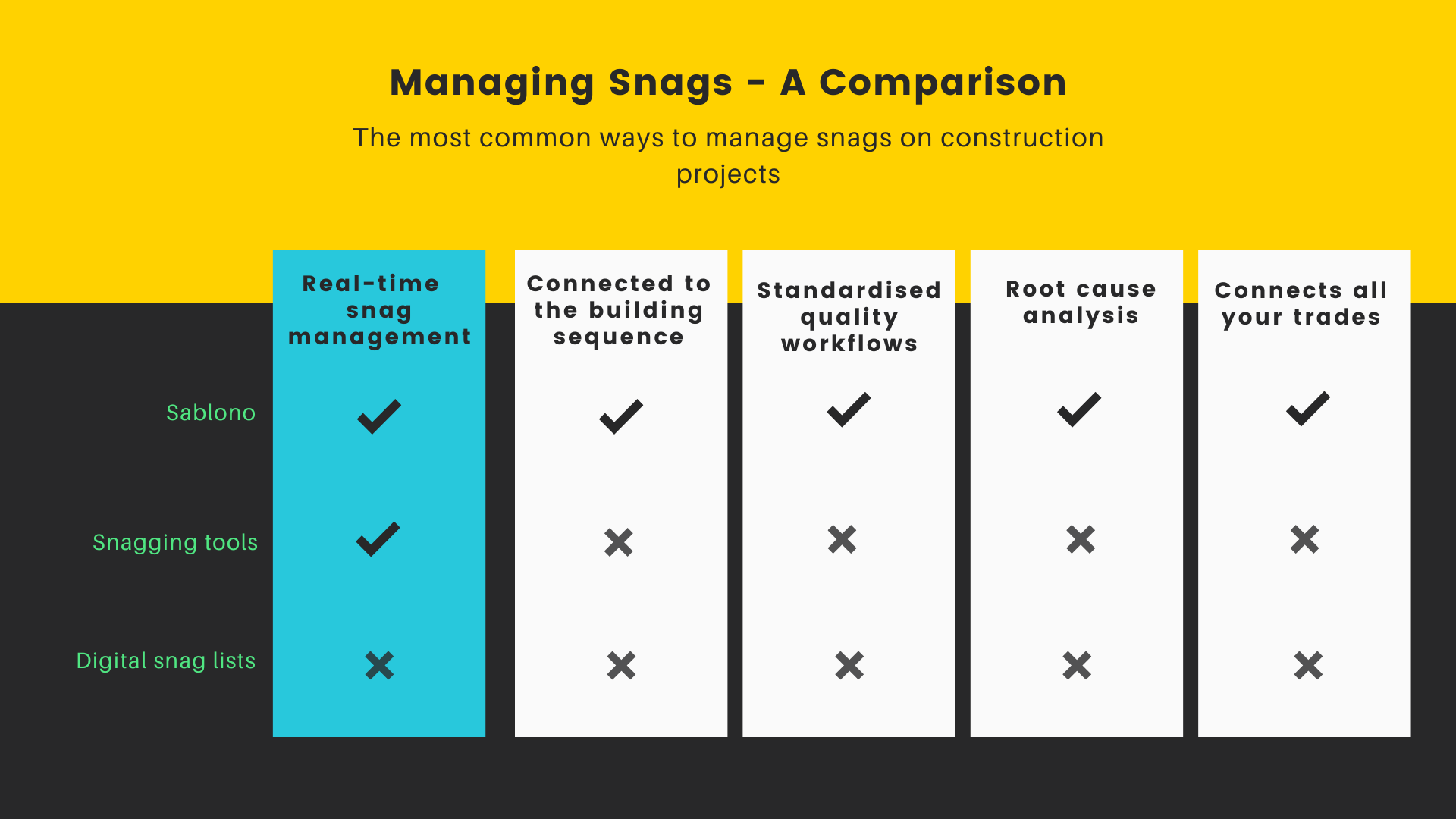Snagging is a normal part of the construction process - but how can we deal with snagging without it slowing us down?
In this article, we will break down the topic of snagging - from the tools most commonly used to deal with snags, to how you can manage snags on your projects more efficiently.
What is snagging in construction?
In construction, snagging refers to the process of identifying outstanding issues which need to be fixed before handover to the client. This is a very important process, as it ensures that all deliverables have been achieved to specific guidelines as per the contract.
What is a snag in construction?
A snag is a defect that occurs in the build that will need to be fixed in order to meet the client’s requirements and ensure the integrity and safety of the final project.
Types of snags in construction projects
There are many snags or defects which may occur during the completion of a project. They can be as simple as a scratch on a wall or door, a chipped tile or a splatter of paint or render. The main cause for concern, however, is that snags ultimately mean delays on a project.
There are also snags which are much more serious, like the malfunction of plumbing or electrical instalments. They may also be issues with structural or foundational elements such as cracks in walls or columns, deteriorated concrete, or an unsealed roof.
Here is a list of some of the most common snags in construction:
- Cracks in walls or facades due to structural movement, incorrect use of materials or faulty materials
- Faulty smoke or carbon dioxide detectors
- Incorrect instalment of underground conduits, resulting in waste water leaks or disruption to major connections like telecommunication or electrical lines
- Design issues - these are not typically frequent, but can range from minor, easy fixes, to major overhauls of areas

What is the process of managing snags in construction?
At the end of the project execution phase, the build is scoped for snags.
Site managers will look for issues and note them down so that they can be rectified before the project is handed over to the client.
What is a snag list?
A construction snag list, otherwise known as a punch list, is a checklist which outlines items to test or inspect for faults. These are often specific to a particular part of a project.
Here is an example of a snag list for the decoration of an apartment build:
- All materials and protection removed
- Area cleaned and all dust removed
- Top coat of paints applied with no visible patching
- All woodwork top coats applied
- No paint marks left on the floor or around light fixing
- Visible inspection of walls to check for brushwork marks
What is a snagging tool?
Another way to manage snags is through snagging tools. Here, the same process applies, but a digital tool in the form of a snagging software solution is used to streamline this process.
You put a pin on your plan to show where the issue has occurred and can then work to fix it.
One benefit of using a snagging tool over traditional snag lists is that it allows you to connect trades on your project through a unified system and notify them of snags that are identified immediately.
Snagging tools also digitalise the snagging process which reduces paperwork and saves time.
Some examples of popular snagging software on the market include:
- Viewpoint Field View
- PlanGrid
- PlanRadar
- SnagR
(Want to learn more about the best solutions to manage snags - read this article)
Who carries out snagging inspections?
Usually, those responsible for the oversight of defects are engineers, foremen, and leading hands who are on site. This is because these project team members often have the best idea of what is happening on a project.
These managers will commence multiple site walks with the aid of snag/punch lists. Information will be recorded on these checklists, and then either placed into yet another list, or handed over to trades.

The problem with the traditional approach to snagging
Although common, the standard approach to snagging which relies on snag lists and snagging tools is not the most efficient way of managing snags. Here’s why:
Outdated data. Projects often see many alterations and changes to plans, and that’s part of what makes construction interesting – thinking on your feet and problem-solving. Unfortunately, snagging tools and punch lists are not designed to be automatically updated, and they can become outdated quickly.
More paperwork. The disconnected nature of the traditional approach to snagging can create multiple spreadsheets, which means more paperwork and more effort to condense many different silos into one usable source of information.
Tunnel vision. Construction snagging software only allows you to manage a small fraction of your operations which leads to inefficient processes in an industry which relies on many teams working together.
Reactive vs proactive. You only manage what’s already gone wrong instead of working to prevent issues from arising in the first place.
Disconnected from the construction site. Snag lists and snagging tools aren’t connected to your building sequence. This means it is hard to understand what is happening in the moment and how snags are interconnected.
Difficult to obtain useful insights. You can record snags but beyond this, it’s difficult to obtain insights that you can use to improve going forward.
Incomplete picture of your project. Snagging information only represents 20% of the project data. Relying on snagging tools in particular doesn’t allow you to take into account the other 80% of what goes on in your project and can therefore be a poor investment in the longer term.
A better way to manage snags on projects - Sablono
Most snagging tools treat snags in their own individual silos. They are isolated from one another and they don’t speak to any other part of the project. The problem is that snags are highly interconnected.
As a construction execution system, Sablono rethinks the typical approach to managing snags in construction. With the Sablono platform, each step of the build is pre-defined. This means that everyone knows in advance what the tasks and expectations are to help prevent snags from occurring.
Managers and contractors can locate issues within a workflow, giving a holistic and connected view of your project. You’ll understand exactly what is happening at any given moment, and how each daily activity affects the next down to the granular level.
The Sablono platform allows you to take a proactive approach to managing snags, so that you can fix, prevent, and learn from the snags that come up on a project. This perspective is better than simply locating issues in a plan because you can immediately see the impact that a snag has on the overall project as well as the root cause.
Sablono provides instant access and distribution of information, anywhere, at any time. Are there new requirements for an area? Are there hazards? Has work moved to a different location? Everything that happens on a project can be addressed and shared in the moment - this is the future of construction.

What can Sablono’s Construction Execution System do?
- What needs to be done in each area
- Quality management and QA checklists
- Snagging
- Trade-to-trade handovers
- Look-ahead planning
- Baseline comparisons
- Full analytics of your projects
- Delay analysis
Get to the root cause of snags
The only way we can minimise defects is to make sure we know why they occurred in the first place. We need to know what went wrong and why it went wrong.
Sablono is a leader in its field when it comes to comprehensive site mapping like this. Because the entire workflow is interconnected, Sablono makes it easy to trace back to understand what caused a snag in the first place.
This differs to snag lists and stand-alone snagging solutions, which really only exist to report faults, not to foresee them, minimize them, or see how they affect future works.
Immediately understand the impact of snags
A dedicated system which understands both immediate works and defects, as well as long-term goals, and how they might be affected by defects and hold-ups.
Sablono connects everything that happens on your project which means that you can instantly view how one activity affects another.
You can understand the true impact of a defect and reschedule trades and tasks if necessary, and immediately alert anyone needing this information.
Learn from mistakes early on in the construction process
With Sablono you can harness look-ahead planning based on reliable data to determine what is the best course of action to take next.
You can also create sequences of works based on data-driven best practices for your tasks and quickly rinse and repeat to scale your production.
For example, let’s say you notice a pattern of snags when executing level 1 of a residential project. The platform makes it possible to correct the defects on time and prevent repeating the same mistakes on subsequent floors. You can then create standardised workflows for the remaining floors to optimise your production.
Turn the management of snags into a team effort
When trades are equally responsible for upholding quality control, then we create a much stronger team. No longer are a handful of managers required to oversee many different aspects and areas. By democratising the process, we find a more robust reporting culture, which leads to fewer errors and a better understanding of a project.
This collaboration makes those who work on deliverables answerable to their completion. Instead of playing an elaborate game of hot potato by having to go back and forth between contractors and project managers, we have a platform which directly links all key members.
![]()
Conclusion: Snagging in construction
Snags will always come up on construction projects, but the approach you take to manage these can be the difference between a successful project delivery and a failed one.
With Sablono, you can be sure that not only will you more efficiently track, fix and prevent issues, but you will also be empowered by a system which guides all construction personnel to build correctly from the start. {You can learn more about this here: Sablono for quality assurance.}
Every contractor task and activity is logged and placed into the system. No more chasing trades, making endless phone calls and relaying information upstream. All key members are automatically notified, and can access information instantly.
We would love to share more information with you on how we can help you to achieve this. We invite you to schedule a personalised demo of Sablono to learn how it can help you streamline your construction snagging process.



